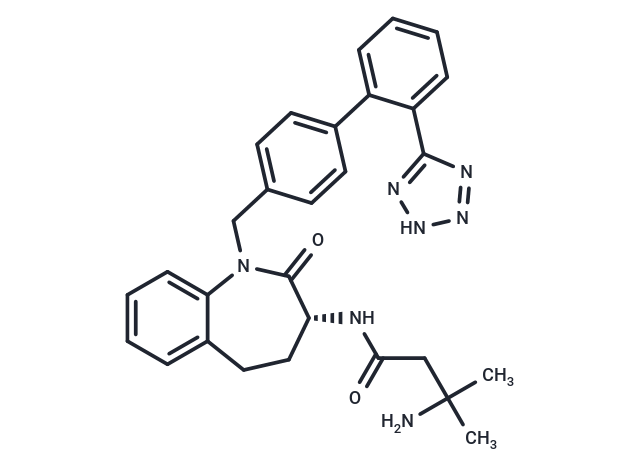Shopping Cart
Remove All Your shopping cart is currently empty
Your shopping cart is currently empty
L-692429 (MK-0751) is a potent nonpeptidyl growth hormone secretagogue (GHS) agonist and benzolactam derivative, known for reversing glucocorticoid-induced inhibition of GH secretion. L-692429 exhibits high affinity for the G protein-coupled receptor and is useful in studying acromegaly and obesity.

| Pack Size | Price | USA Warehouse | Global Warehouse | Quantity |
|---|---|---|---|---|
| 1 mg | $158 | In Stock | In Stock | |
| 5 mg | $396 | In Stock | In Stock | |
| 10 mg | $589 | In Stock | In Stock | |
| 25 mg | $943 | In Stock | In Stock | |
| 50 mg | $1,280 | In Stock | In Stock | |
| 100 mg | $1,720 | - | In Stock | |
| 1 mL x 10 mM (in DMSO) | $445 | In Stock | In Stock |
| Description | L-692429 (MK-0751) is a potent nonpeptidyl growth hormone secretagogue (GHS) agonist and benzolactam derivative, known for reversing glucocorticoid-induced inhibition of GH secretion. L-692429 exhibits high affinity for the G protein-coupled receptor and is useful in studying acromegaly and obesity. |
| Targets&IC50 | intracellular calcium:26 nM (EC50), inositol phosphate (IP) turnover:47 nM (EC50), Serum-responsive element activity:63 nM (EC50), BRET:58 nM (EC50), CREB:60 nM (EC50) |
| In vitro | L-692429, a chemical compound, activates various cellular mechanisms, including intracellular calcium release, inositol phosphate (IP) turnover, cAMP-responsive element binding protein (CREB) activity, serum-responsive element activity, and bioluminescence resonance energy transfer (BRET) activity, with EC50 values of 26 nM, 47 nM, 60 nM, 63 nM, and 58 nM, respectively[2]. In experiments involving HeLa-T4 cells, those transiently expressing flag epitope-tagged growth hormone secretagogue (GHS) receptor and treated with L-692429 show a measurable increase in intracellular calcium, as detected by fluorometry using fluo-3/AM calcium indicator dye. This response is absent in untransfected HeLa-T4 cells, indicating the specificity of L-692429 for GHS receptor-expressing cells. Moreover, L-692429 treatment significantly enhances luciferase activity in these cells, suggesting that GHS receptor activation triggers the MAPK pathway[1]. |
| In vivo | In anesthetized Wistar rats, L-756867 dose-dependently suppresses GH secretion stimulated by L-692429 (100 μg/kg), with complete inhibition achieved at an intravenous dose of 100 μg/kg of L-756867[3]. |
| Synonyms | MK-0751 |
| Molecular Weight | 509.614 |
| Formula | C29H31N7O2 |
| Cas No. | 145455-23-8 |
| Smiles | CC(C)(N)CC(=O)N[C@@H]1CCc2ccccc2N(Cc2ccc(cc2)-c2ccccc2-c2nn[nH]n2)C1=O |
| Relative Density. | 1.31g/cm3 |
| Storage | Powder: -20°C for 3 years | In solvent: -80°C for 1 year | Shipping with blue ice/Shipping at ambient temperature. | ||||||||||||||||||||||||||||||
| Solubility Information | DMSO: 40 mg/mL (78.49 mM), Sonication is recommended. | ||||||||||||||||||||||||||||||
| In Vivo Formulation | 10% DMSO+40% PEG300+5% Tween 80+45% Saline: 2 mg/mL (3.92 mM), Sonication is recommended. Please add the solvents sequentially, clarifying the solution as much as possible before adding the next one. Dissolve by heating and/or sonication if necessary. Working solution is recommended to be prepared and used immediately. The formulation provided above is for reference purposes only. In vivo formulations may vary and should be modified based on specific experimental conditions. | ||||||||||||||||||||||||||||||
Solution Preparation Table | |||||||||||||||||||||||||||||||
DMSO
| |||||||||||||||||||||||||||||||
| Size | Quantity | Unit Price | Amount | Operation |
|---|

Copyright © 2015-2025 TargetMol Chemicals Inc. All Rights Reserved.